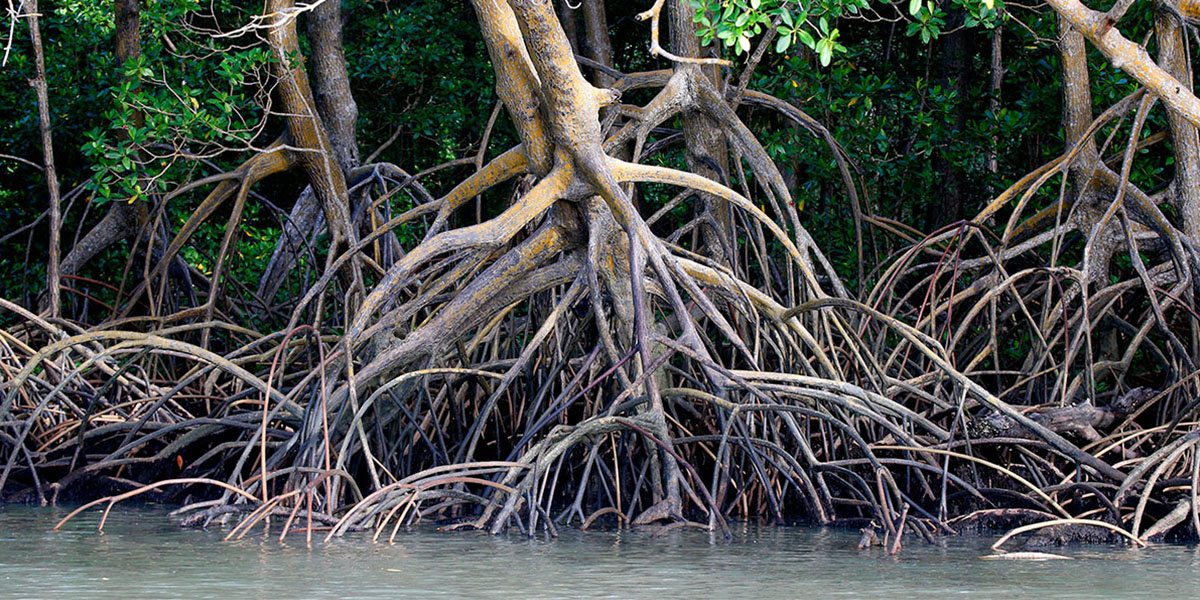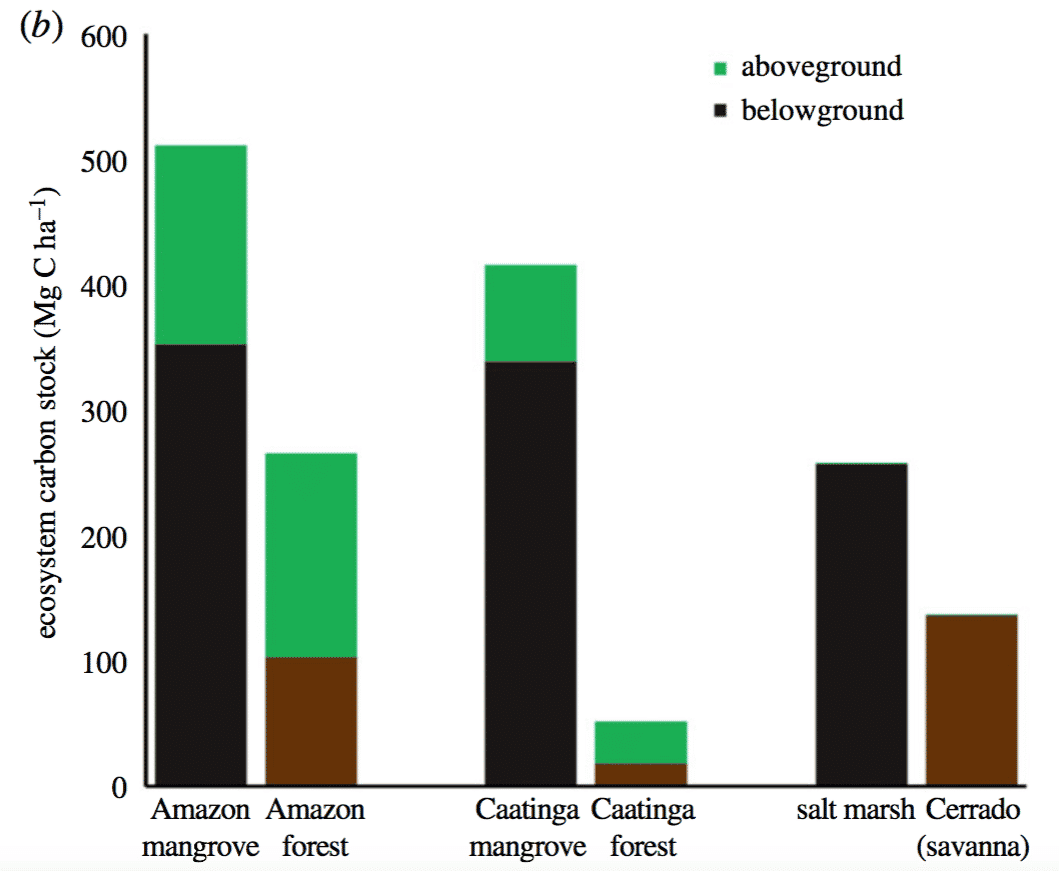

Roots of mangrove trees, Para State, Brazil. Ricardo Lima / Getty Images
By Daisy Dunne
The vast mangroves of the Amazon store twice as much carbon per hectare as the region’s tropical forests, new research shows.
The relatively understudied ecosystem also stores 10 times more carbon than Amazon savannahs—a type of grassy plain with sparsely populated trees, according to the study.
However, the wetlands face threats from deforestation and climate change, the researchers say. Introducing more measures to protect mangroves will be key to preserving its large carbon store, they add.
The findings provide “yet more evidence of the extraordinary carbon stocks found in mangroves” worldwide, another scientist told Carbon Brief.
Wild Wetlands
The Amazon is well known for its 167m hectares of rainforest, but is less known for being home to close to 1m hectares of “mangrove” forests.
Mangroves are trees and shrubs that grow in coastal waters across the tropics and subtropics. They are most easily recognized by their tall protruding roots, which they use to anchor themselves against incoming tides.
The new study, published in Biology Letters, is the first to make an on-the-ground estimate of how much carbon is stored in the Amazon’s vast wetlands.
It finds that, on average, Amazon mangroves store 511 tonnes of carbon per hectare—roughly double that of the region’s rainforests. Writing in their research paper, the authors said:
“The carbon stocks of the Amazon mangroves were over twice those of upland evergreen forests [rainforests] and almost 10-fold those of tropical dry forest [savannahs].”
Calculating Carbon
For the study, the researchers visited nine mangroves—along with three salt marshes (a type of coastal grassland)—within the Brazilian Amazon.
At each site, they took measurements of the amount of carbon stored “aboveground,” in the trees and fallen leaf litter, and “belowground,” in the roots and soil.
To measure carbon stocks, the researchers measured changes to “biomass”—the weight amassed from the production of new leaves and shoots, or the thickening of a tree trunk, for example.
Plants take in CO2 from the atmosphere during photosynthesis and later use it to build and extend their trunks, stems and roots. Because of this, measuring changes to biomass gives scientists an idea of how much carbon is being stored in a given area over time.
The researchers then compared their estimates to previous data on carbon storage in the Amazon rainforest.
The chart below shows the average amount of carbon stored in tonnes per hectare by Amazon mangroves (far left) and Amazon rainforests (second left). The charts also include results from the salt marshes (second right) and data taken from a previous study by the researchers undertaken in desert-like “Caatinga” and savannah-like “Cerrado” ecosystems.
On the chart, green shows the results for aboveground carbon, brown shows the results for shallow belowground carbon and black shows the result for deep belowground carbon. (Rainforest soil tends to be shallow and nutrient-poor, while deep deposits of soil can build up in mangrove forests.)
Estimated carbon stock in tonnes per hectare in Amazon mangroves and forests, “Caatinga” (desert-like) mangroves and forests, salt marshes and “Cerrado” (savannah) ecosystemsBoone Kaufmann et al. (2018)
The results show that, on average, Amazon mangroves store around twice as much carbon per hectare as Amazon forests.
The majority of the carbon stored by mangroves is held in the soil, the research shows. Wetland soils tend to be carbon-rich because they are waterlogged, which slows the rate at which plant matter decomposes.
When decomposition is slow, carbon-rich materials are able to build up, explained Dr. Mark Spalding, a marine scientist and honorary fellow at the University of Cambridge, who was not involved in the study. He told Carbon Brief:
“The soils are very carbon rich. This is because they are permanently waterlogged and, so, carbon doesn’t break down. Freshwater peats have similar soil carbon concentrations.”
The tightly-packed nature of mangrove trees also enhances carbon storage in comparison to forests, which tend to be more sparse, he added.
Looming Threats
The results suggest that protecting the Amazon wetlands could play a larger role in slowing climate change than previously thought, the authors say.
Amazon wetlands are currently threatened by deforestation—often to make way for fish farming—as well as rising temperatures, which could cause wetlands to dry out by increasing rates of evaporation. In their research paper, the authors said:
“The vast extent of Brazilian mangroves coupled with the large quantities of greenhouse gas emissions that results from deforestation underscores their potential value in climate change mitigation.”
The findings provide evidence of the “extraordinary carbon stocks found in mangroves,” Spalding said, but a key question remains about how stable this carbon is:
“Whether this carbon is short-lived or whether a significant proportion is being buried for the long-term in offshore sediments is a very important research question.”
Tropical Forests Lost 40 Football Fields of Tree Cover Per Minute in 2017 https://t.co/Xp1B25yonb @EARTHWORKS @GreenpeaceAustP
— EcoWatch (@EcoWatch) June 27, 2018
Reposted with permission from our media associate Carbon Brief.
- 8 Ways to Sequester Carbon to Avoid Climate Catastrophe
- Best Type of Forest for CO2 Storage Depends on Location and Climate, Study Finds - EcoWatch

 233k
233k  41k
41k  Subscribe
Subscribe 
